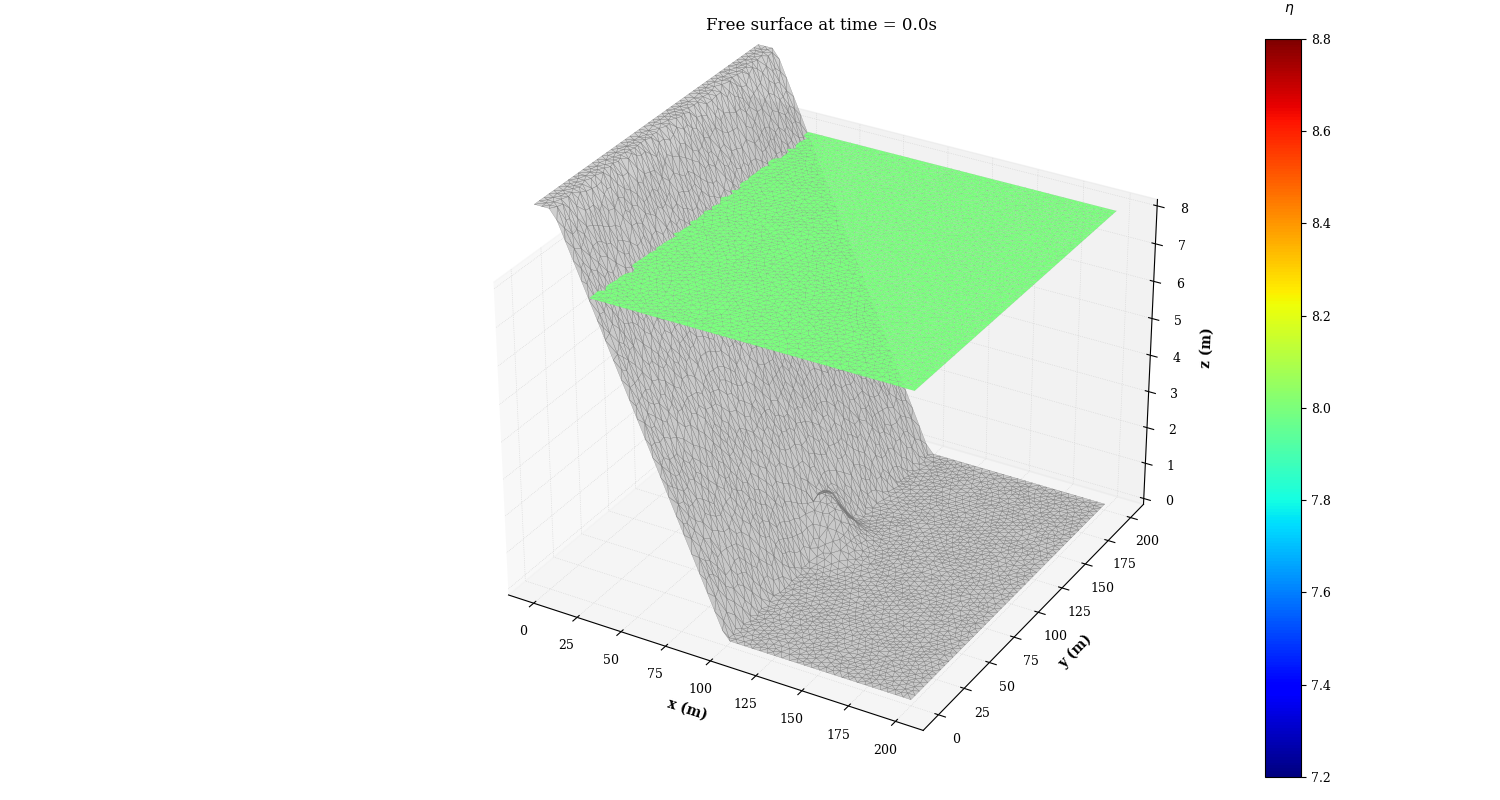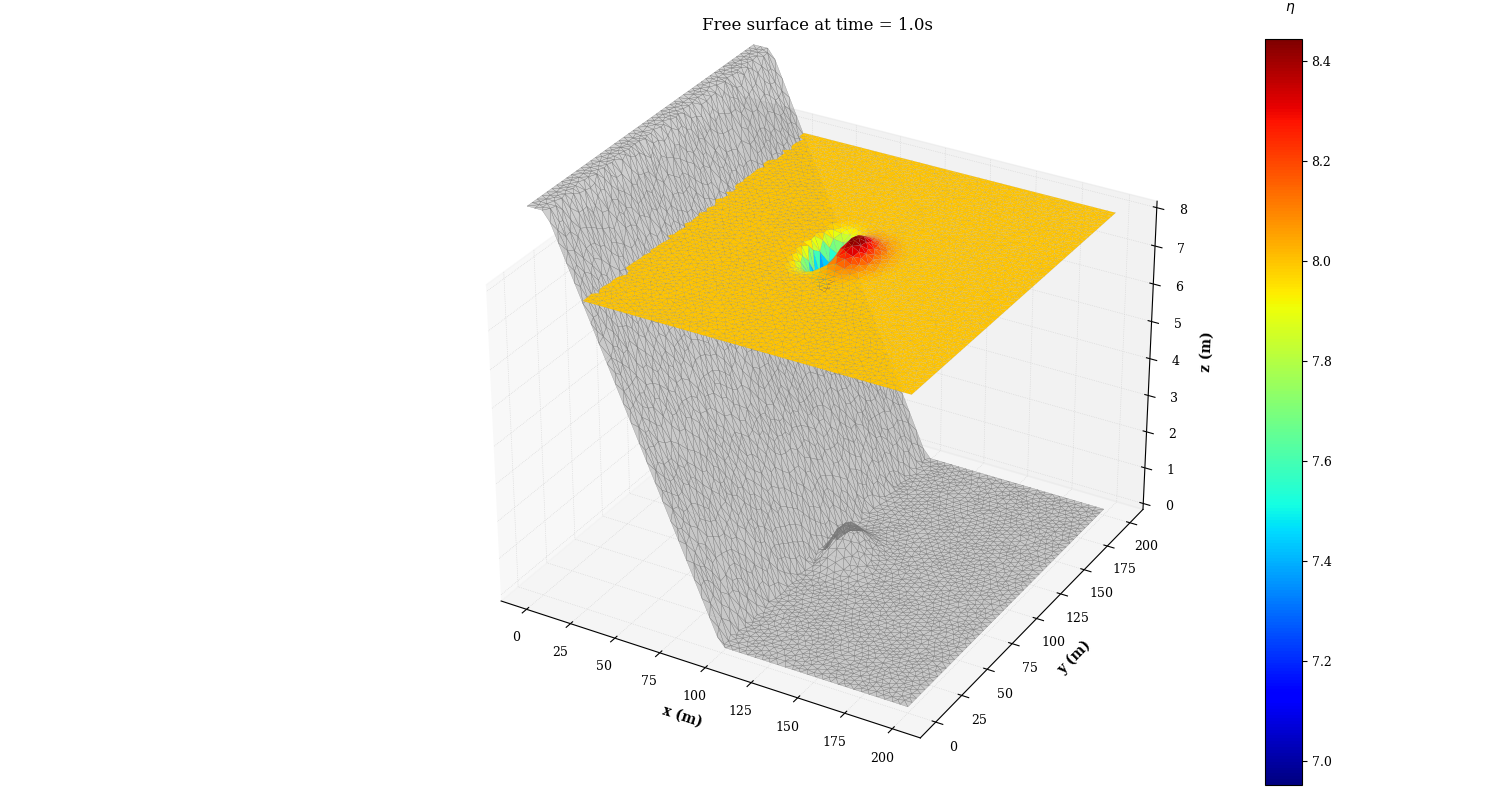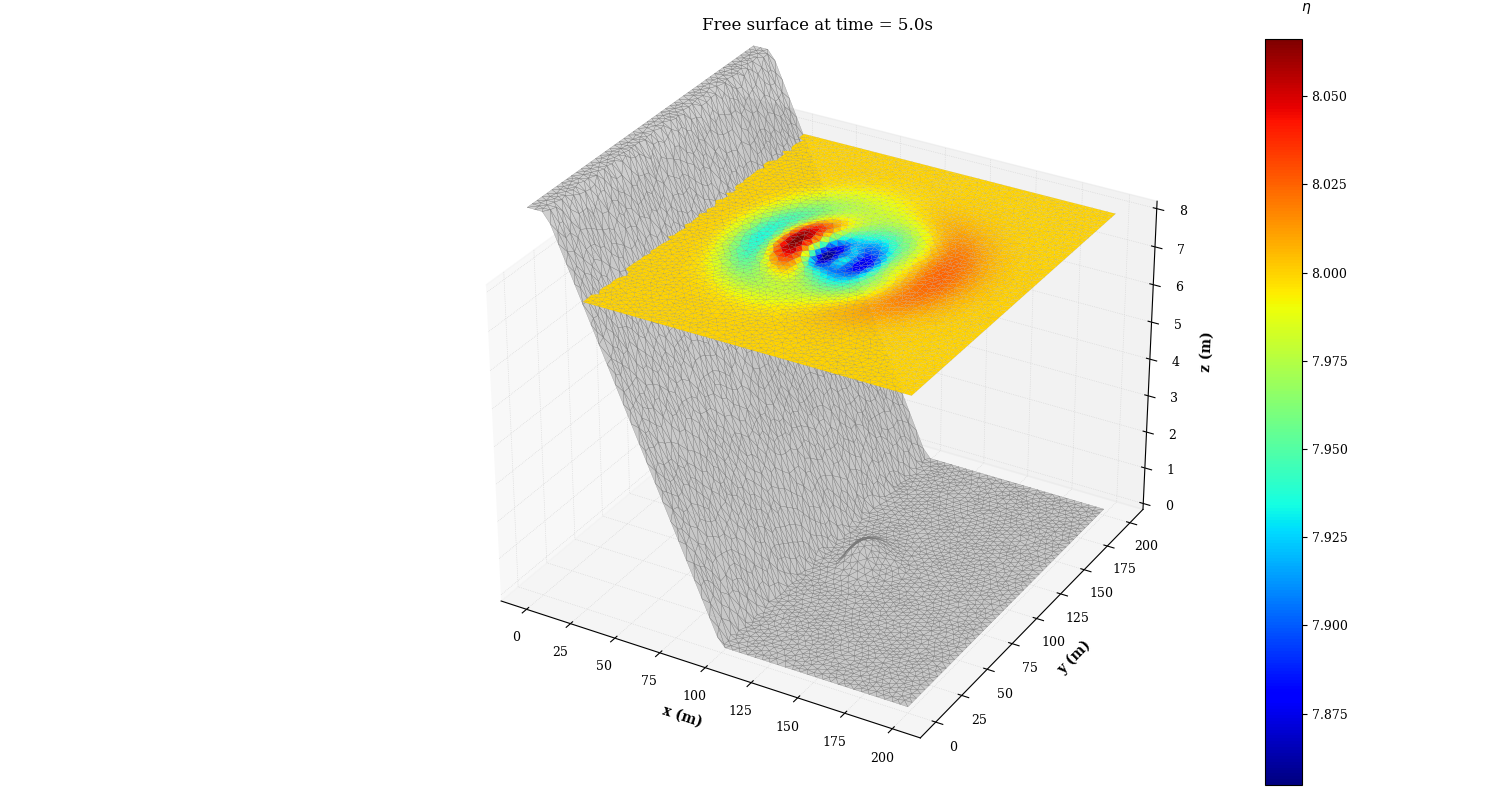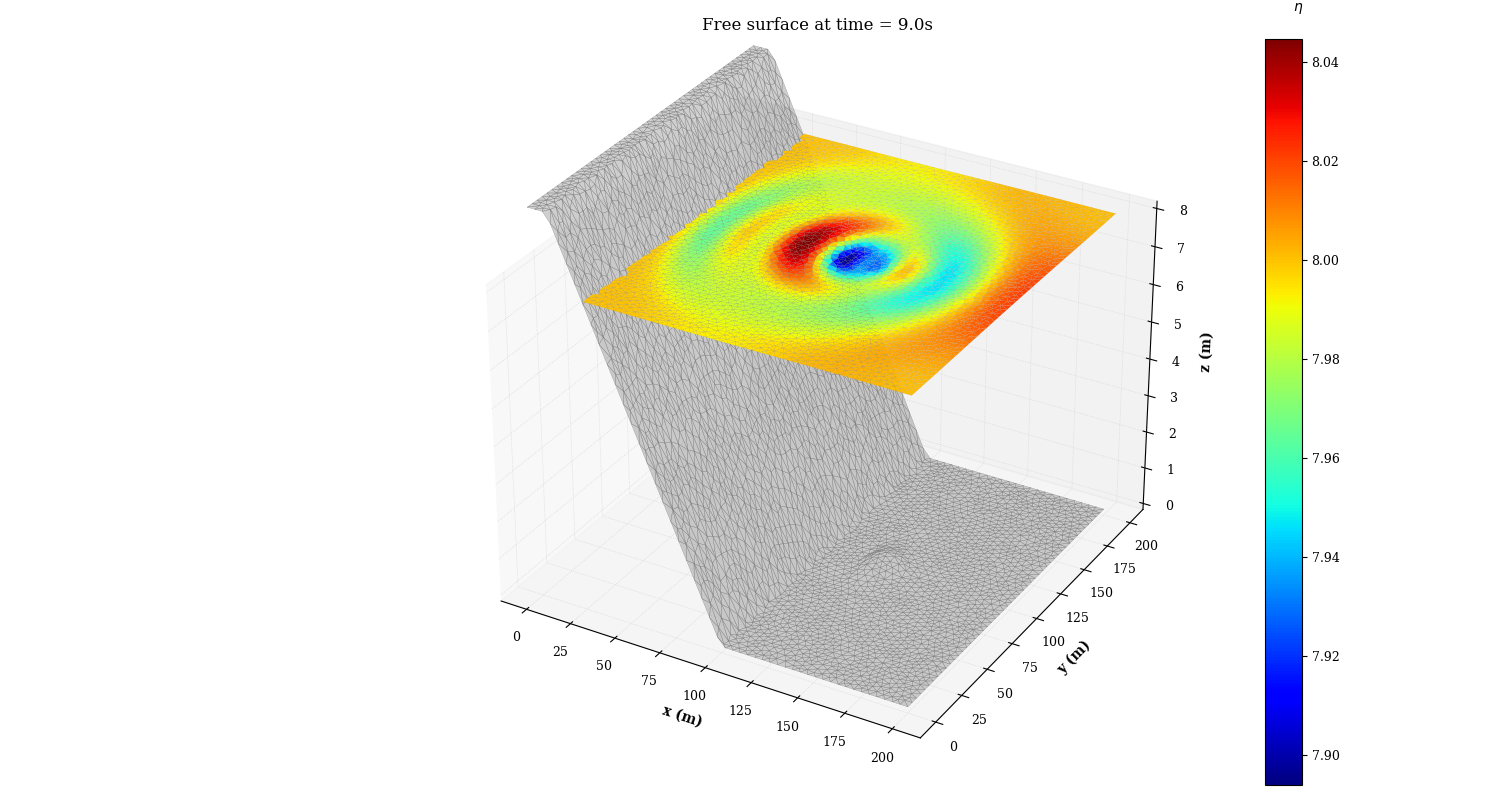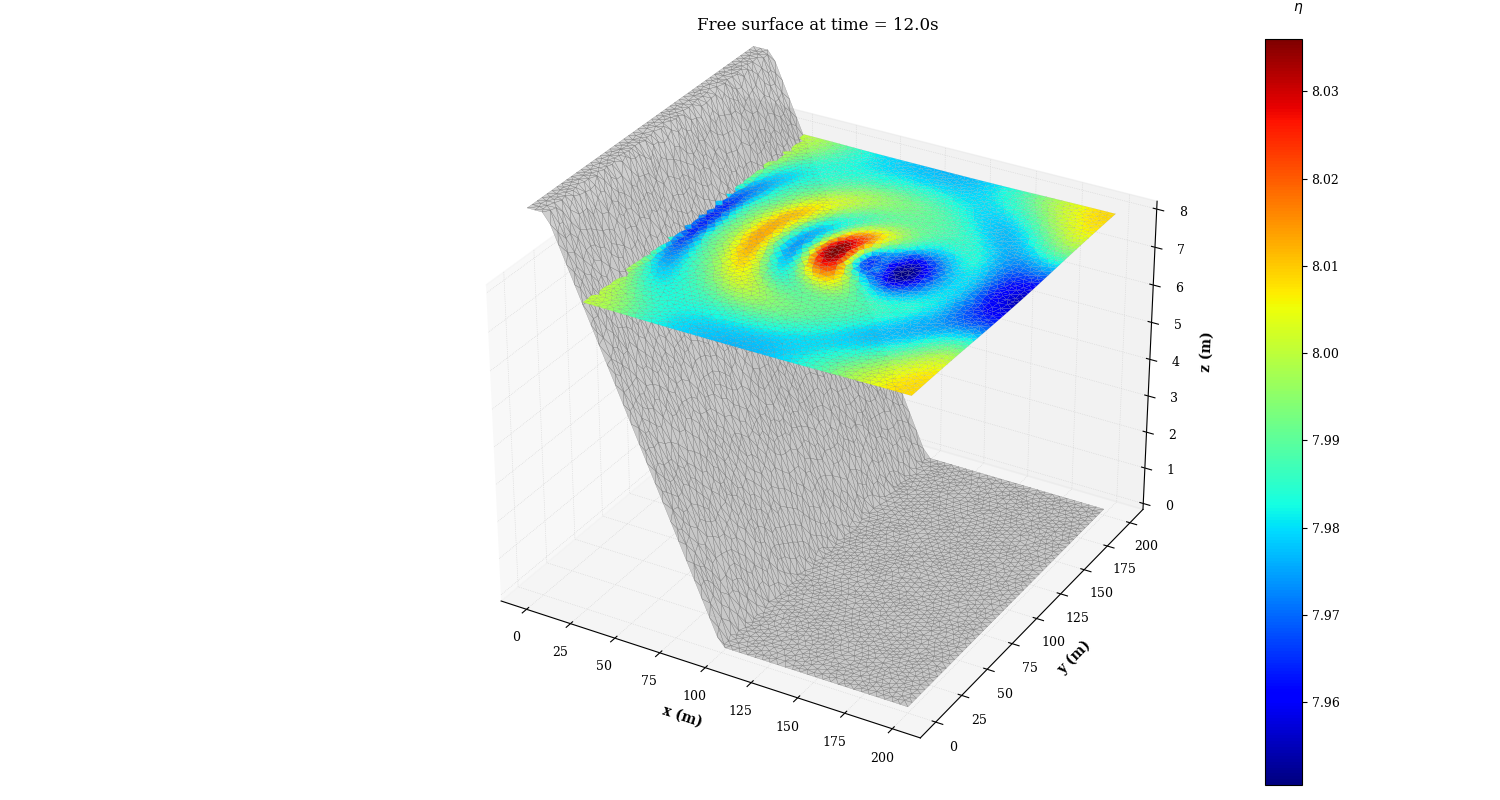Note
Click here to download the full example code
Topography source¶
This is a simple topography source case showing the ability of freshkiss3d to apply source terms on toporgaphy to simulate bed movement induced phenomena like tsunamis.
import os, sys
import argparse
import numpy as np
import random as rd
import matplotlib.pylab as plt
import freshkiss3d as fk
import freshkiss3d.extra.plots as fk_plt
from scipy.interpolate import griddata
os.system('rm -r outputs')
#sphinx_gallery_thumbnail_number = 5
parser = argparse.ArgumentParser()
parser.add_argument('--nographics', action='store_true')
args = parser.parse_args()
def load_landslice(dir_path_z_variations):
files_path_z_variations = os.listdir(dir_path_z_variations)
times = []
xt_grid = []
yt_grid = []
zbt_grid = []
for ffile in files_path_z_variations:
path_ffile = dir_path_z_variations+'/'+ffile
x_grid = []
y_grid = []
zb_grid = []
with open(path_ffile, "r") as f:
time = f.readline()
time = float(time)
times.append(time)
lines = f.readlines()
for line in lines:
line = line.split(";")
line = [float(i) for i in line]
x_grid.append(line[0])
y_grid.append(line[1])
zb_grid.append(line[2])
x_grid = np.array(x_grid, dtype='d')
y_grid = np.array(y_grid, dtype='d')
zb_grid = np.array(zb_grid, dtype='d')
xt_grid.append(x_grid)
yt_grid.append(y_grid)
zbt_grid.append(zb_grid)
xt_grid = [i for _,i in sorted(zip(times, xt_grid))]
yt_grid = [i for _,i in sorted(zip(times, yt_grid))]
zbt_grid = [i for _,i in sorted(zip(times, zbt_grid))]
times = sorted(times)
return xt_grid, yt_grid, zbt_grid, times
def msh_points_into_data_domain(x_msh, y_msh, max_x_grid, min_x_grid, \
max_y_grid, min_y_grid):
x_msh_in_grid = []
y_msh_in_grid = []
C_msh_in_grid = []
C = 0
for x, y in zip(x_msh, y_msh):
if min_x_grid < x < max_x_grid:
if min_y_grid < y < max_y_grid:
x_msh_in_grid.append(x)
y_msh_in_grid.append(y)
C_msh_in_grid.append(C)
C += 1
return x_msh_in_grid, y_msh_in_grid, C_msh_in_grid
def load_zb_init(x_msh, y_msh, topo_xy, x_msh_in_grid, y_msh_in_grid, \
zt_msh_in_grid):
NC = len(x_msh)
zb = np.empty(NC, dtype = 'd')
for C in range(NC):
zb[C] = topo_xy(x_msh[C], y_msh[C])
zb_0 = {}
c = 0
for x_fk, y_fk in zip(x_msh, y_msh):
zb_0[(x_fk, y_fk)] = zb[c]
c += 1
c = 0
for x, y in zip(x_msh_in_grid, y_msh_in_grid):
if (x, y) in zb_0:
zb_0[(x, y)] += zt_msh_in_grid[0][c]
c += 1
zb_0 = np.array(list(zb_0.values()),dtype='d')
return zb_0
def interpolate_topography_data_on_freshkiss_mesh(x_msh, y_msh, xt_data, yt_data, \
zbt_data, interpolate_method='nearest'):
if interpolate_method not in ('nearest', 'linear', 'cubic'):
raise ValueError(
"Choose between these interpolate methods :\n"
"'nearest', 'linear', 'cubic'\n"
)
zt_msh = []
if interpolate_method=='nearest':
for x_data, y_data, zb_data in zip(xt_data, yt_data, zbt_data):
zt_msh.append(griddata((x_data, y_data), \
zb_data, (x_msh, y_msh), \
method = 'nearest'))
if interpolate_method=='linear':
for x_data, y_data, zb_data in zip(xt_data, yt_data, zbt_data):
zt_msh.append(griddata((x_data, y_data), \
zb_data, (x_msh, y_msh), \
method = 'linear'))
if interpolate_method=='cubic':
for x_data, y_data, zb_data in zip(xt_data, yt_data, zbt_data):
zt_msh.append(griddata((x_data, y_data), \
zb_data, (x_msh, y_msh), \
method = 'cubic'))
print("Using method {} to set data to Freshkiss3d.\n"\
.format(interpolate_method))
return zt_msh
Time loop:¶
FINAL_TIME = 15.
simutime = fk.SimuTime(final_time=FINAL_TIME, time_iteration_max=20000, \
second_order=True)
create_figure_scheduler = fk.schedules(times=[0., 1., 5., 9., 12., 15.])
Mesh:¶
dir_path = os.path.abspath(os.path.dirname(sys.argv[0]))
TG, vertex_labels, boundary_labels = fk.read_msh(dir_path + '/inputs/square2.mesh')
x = np.asarray(TG.x)
y = np.asarray(TG.y)
x *= 10.
y *= 10.
triangular_mesh = fk.TriangularMesh(TG, vertex_labels, boundary_labels)
if not args.nographics:
fk_plt.plot_mesh(triangular_mesh)
x_msh = np.asarray(TG.x)
y_msh = np.asarray(TG.y)

Topography source term:¶
ExternalEffects objects are called in problem.solve() at each time step. In
this example external effects are TopographySource.
There can be as much external effects as needed as long as they are stored in a
dictionary type.
Let us consider four cases:
In the first case we define continuous topography source over time to simulate a slowly moving bed.
In the second case we define sparse topography source over time to simulate sudden modification of the bed like a landslide.
In the third case we read several files which contain the topography coordinates (x, y, zb)
for several times for the whole domain.
In the fourth case we read several files which contain the topography coordinates (x, y, zb)
for several times for the moved part of the domain
Note
Note that in both cases (continuous or sparse over time), the source can either be
homogeneous or heterogeneous in space i.e. user can set either a constant set of sources
with the sources parameter or a function (or set of function) of x, y with
the sources_funct parameter. User can also set a vector of size (NC) containing
the source term on each cell of the mesh with the sources_cell parameter.
For given coordinates, we can interpolate the data on the mesh with different methods :
nearest (neighbour), linear or cubic.
CASE = 4
if CASE == 1:
# The bed movement rate in set in m/s with ``source_unit='m/s'``.
def bed_source_rate(x, y, x_0=90., y_0=100.):
return .2*np.exp(-.005*((x-(x_0+5.))**2+(y-y_0)**2)) \
- .2*np.exp(-.005*((x-(x_0-5.))**2+(y-y_0)**2))
if not args.nographics:
fk_plt.plot_init_1d(triangular_mesh, bed_source_rate,
absc='x', ordo='Bed source rate $m/s$', title='Source term')
continuously_moving_bed = fk.TopographySource(
times=[1., 10.],
sources_funct=bed_source_rate,
source_unit='m/s')
external_effects = {"bed": continuously_moving_bed}
elif CASE == 2:
# The landslide in set in m with ``source_unit='m'`` and occurs at :math:`t=1s`
def landslide_source(x, y, x_0=90., y_0=100.):
return 2.0*np.exp(-.005*((x-(x_0+5.))**2+(y-y_0)**2)) \
- 2.0*np.exp(-.005*((x-(x_0-5.))**2+(y-y_0)**2))
if not args.nographics:
fk_plt.plot_init_1d(triangular_mesh, landslide_source,
absc='x', ordo='Landslide source $m$', title='Source term')
tsunami = fk.TopographySource(
times=[1.],
sources_funct=landslide_source,
source_unit='m')
external_effects = {"tsunami": tsunami}
elif CASE == 3:
dir_path_z_variations = dir_path + "/inputs/landslide"
xt_grid, yt_grid, zbt_grid, times = \
load_landslice(dir_path_z_variations)
zt_msh = interpolate_topography_data_on_freshkiss_mesh(\
x_msh, y_msh, xt_grid, yt_grid, zbt_grid)
Dzt_msh = []
for i in range(len(zt_msh)-1):
Dzt_msh.append(zt_msh[i+1] - zt_msh[i])
tsunami = fk.TopographySource(
times = times[1::],
sources_cell = Dzt_msh,
source_unit = 'm')
external_effects = {"tsunami": tsunami}
elif CASE == 4:
dir_path_z_variations = dir_path + "/inputs/landslide_part_domain"
xt_grid, yt_grid, zbt_grid, times = \
load_landslice(dir_path_z_variations)
max_x_grid = max(xt_grid[0])
min_x_grid = min(xt_grid[0])
max_y_grid = max(yt_grid[0])
min_y_grid = min(yt_grid[0])
x_msh_in_grid, y_msh_in_grid, C_msh_in_grid = \
msh_points_into_data_domain(x_msh, y_msh, max_x_grid, \
min_x_grid, max_y_grid, min_y_grid)
zt_msh_in_grid = interpolate_topography_data_on_freshkiss_mesh(\
x_msh_in_grid, y_msh_in_grid, xt_grid, yt_grid, zbt_grid)
Dzt_msh = []
for i in range(len(zt_msh_in_grid)-1):
Dzt_msh.append(zt_msh_in_grid[i+1] - zt_msh_in_grid[i])
tsunami = fk.TopographySource(
times = times[1::],
sources_cell = Dzt_msh,
cells = C_msh_in_grid,
source_unit = 'm')
external_effects = {"tsunami": tsunami}
else:
external_effects = None
Using method nearest to set data to Freshkiss3d.
Layers:¶
FREE_SURFACE = 8.0
X_1 = 10. ; X_2 = 100.
def topo(x, y):
if x < X_1:
topo = 10.0
elif x > X_2:
topo = 0.0
else:
topo = -(10.0/(X_2-X_1))*(x - X_2)
return topo
NL = 2
if CASE == 3:
NC = triangular_mesh.NV
zb_0 = np.zeros(NC, dtype='d')
for C in range(NC):
zb_0[C] = topo(x_msh[C], y_msh[C]) + zt_msh[0][C]
layer = fk.Layer(NL, triangular_mesh, topography=zb_0)
elif CASE == 4:
zb_0 = load_zb_init(x_msh, y_msh, topo, x_msh_in_grid, y_msh_in_grid, \
zt_msh_in_grid)
layer = fk.Layer(NL, triangular_mesh, topography=zb_0)
else:
layer = fk.Layer(NL, triangular_mesh, topography_funct=topo)
Primitives:¶
primitives = fk.Primitive(triangular_mesh, layer, free_surface=FREE_SURFACE)
Boundary conditions:¶
slides = [fk.Slide(ref=r) for r in [1,2,3,4]]
Writter:¶
vtk_writer = fk.VTKWriter(triangular_mesh, scheduler=fk.schedules(count=10),
scale_h=3.)
Problem definition:¶
problem = fk.Problem(simutime, triangular_mesh,
layer, primitives,
slides=slides,
external_effects=external_effects,
vtk_writer=vtk_writer,
custom_funct={'plot':fk_plt.plot_freesurface_topo_3d},
custom_funct_scheduler=create_figure_scheduler)
===================================================================
| INITIALIZATION |
===================================================================
Problem size: Nodes=3303, Layers=2, Triangles=6408,
Iter = 0 ; Dt = 0.0000s ; Time = 0.00s ; ETA = 0.00s
Problem solving:¶
problem.solve()
if not args.nographics:
plt.show()
===================================================================
| TIME LOOP |
===================================================================
Iter = 8 ; Dt = 0.0389s ; Time = 0.31s ; ETA = 3.14s
Iter = 16 ; Dt = 0.0389s ; Time = 0.62s ; ETA = 3.07s
Iter = 24 ; Dt = 0.0389s ; Time = 0.93s ; ETA = 3.01s
Iter = 32 ; Dt = 0.0389s ; Time = 1.24s ; ETA = 2.93s
Iter = 40 ; Dt = 0.0388s ; Time = 1.55s ; ETA = 2.85s
Iter = 48 ; Dt = 0.0387s ; Time = 1.86s ; ETA = 2.84s
Iter = 56 ; Dt = 0.0386s ; Time = 2.17s ; ETA = 2.81s
Iter = 64 ; Dt = 0.0385s ; Time = 2.48s ; ETA = 2.76s
Iter = 72 ; Dt = 0.0385s ; Time = 2.79s ; ETA = 2.64s
Iter = 80 ; Dt = 0.0385s ; Time = 3.10s ; ETA = 2.58s
Iter = 87 ; Dt = 0.0386s ; Time = 3.37s ; ETA = 2.53s
Iter = 95 ; Dt = 0.0387s ; Time = 3.68s ; ETA = 2.45s
Iter = 103 ; Dt = 0.0388s ; Time = 3.99s ; ETA = 2.35s
Iter = 111 ; Dt = 0.0389s ; Time = 4.30s ; ETA = 2.34s
Iter = 119 ; Dt = 0.0389s ; Time = 4.61s ; ETA = 2.27s
Iter = 127 ; Dt = 0.0389s ; Time = 4.92s ; ETA = 2.15s
Iter = 135 ; Dt = 0.0389s ; Time = 5.23s ; ETA = 2.07s
Iter = 143 ; Dt = 0.0389s ; Time = 5.54s ; ETA = 2.02s
Iter = 150 ; Dt = 0.0389s ; Time = 5.82s ; ETA = 1.98s
Iter = 158 ; Dt = 0.0389s ; Time = 6.13s ; ETA = 1.91s
Iter = 166 ; Dt = 0.0389s ; Time = 6.44s ; ETA = 1.84s
Iter = 174 ; Dt = 0.0388s ; Time = 6.75s ; ETA = 1.80s
Iter = 182 ; Dt = 0.0388s ; Time = 7.06s ; ETA = 1.70s
Iter = 190 ; Dt = 0.0389s ; Time = 7.37s ; ETA = 1.64s
Iter = 198 ; Dt = 0.0389s ; Time = 7.68s ; ETA = 1.58s
Iter = 206 ; Dt = 0.0389s ; Time = 7.99s ; ETA = 1.51s
Iter = 213 ; Dt = 0.0389s ; Time = 8.27s ; ETA = 1.46s
Iter = 221 ; Dt = 0.0389s ; Time = 8.58s ; ETA = 1.41s
Iter = 229 ; Dt = 0.0389s ; Time = 8.89s ; ETA = 1.33s
Iter = 237 ; Dt = 0.0390s ; Time = 9.20s ; ETA = 1.23s
Iter = 245 ; Dt = 0.0390s ; Time = 9.51s ; ETA = 1.16s
Iter = 253 ; Dt = 0.0390s ; Time = 9.82s ; ETA = 1.13s
Iter = 261 ; Dt = 0.0390s ; Time = 10.14s ; ETA = 1.04s
Iter = 269 ; Dt = 0.0390s ; Time = 10.45s ; ETA = 0.96s
Iter = 276 ; Dt = 0.0390s ; Time = 10.72s ; ETA = 0.90s
Iter = 284 ; Dt = 0.0390s ; Time = 11.03s ; ETA = 0.83s
Iter = 292 ; Dt = 0.0389s ; Time = 11.34s ; ETA = 0.79s
Iter = 300 ; Dt = 0.0388s ; Time = 11.65s ; ETA = 0.72s
Iter = 308 ; Dt = 0.0387s ; Time = 11.96s ; ETA = 0.65s
Iter = 316 ; Dt = 0.0387s ; Time = 12.27s ; ETA = 0.58s
Iter = 324 ; Dt = 0.0387s ; Time = 12.58s ; ETA = 0.52s
Iter = 332 ; Dt = 0.0387s ; Time = 12.89s ; ETA = 0.45s
Iter = 339 ; Dt = 0.0388s ; Time = 13.17s ; ETA = 0.39s
Iter = 347 ; Dt = 0.0388s ; Time = 13.48s ; ETA = 0.33s
Iter = 355 ; Dt = 0.0388s ; Time = 13.79s ; ETA = 0.26s
Iter = 363 ; Dt = 0.0388s ; Time = 14.10s ; ETA = 0.19s
Iter = 371 ; Dt = 0.0388s ; Time = 14.41s ; ETA = 0.13s
Iter = 379 ; Dt = 0.0388s ; Time = 14.72s ; ETA = 0.06s
Iter = 387 ; Dt = 0.0110s ; Time = 15.00s ; ETA = 0.00s
===================================================================
| END |
===================================================================
Problem.solve() completed in 6.336383581161499s (wall time)
Total running time of the script: ( 0 minutes 10.386 seconds)
